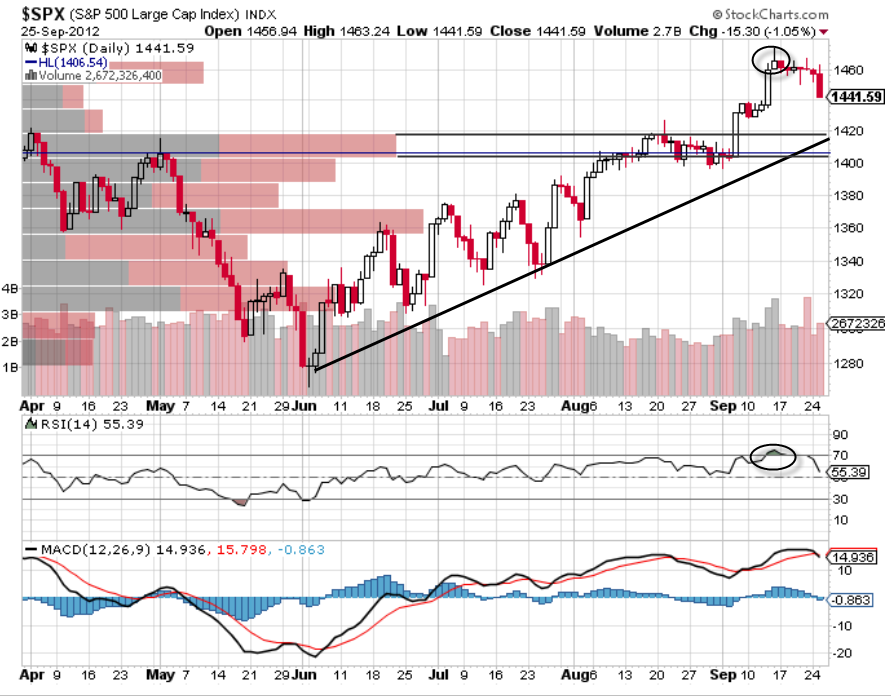by Michael Tarsala, CMT
U.S. stocks saw their heaviest selling since late June on Tuesday following Philly Fed Chief Charles Plosser’s negative comments about QE3 and austerity protests in Spain. Still, I believe that technical signals at this point are pointing to a minor market pullback.
In a moment, I’ll explain why I think a decline to near-term supports in the 1,400 to 1,420 area is possible, why it would not necessarily break the market’s uptrend, and why a fall below that support area would be considered something more serious.
First, I believe that Plosser’s comments should not have come as a big surprise. He is known as an inflation hawk and previously expressed doubts about the Fed bond buying program.
In a speech Tuesday at The Bond Club of Philadelphia, he suggested that the latest Fed stimulus is unlikely to boost growth, won’t reduce interest rates significantly, and comes with risks.
“I believe that increasing monetary policy accommodation is neither appropriate nor likely to be effective in the current environment, Plosser said, adding that the Fed may have jeopardized its credibility and its future sway on policy if QE3 doesn’t work.
His comments, along with calls for Spain’s parliament to be dissolved, nevertheless helped to spark the Tuesday pullback. Additional concerns on the day included Caterpillar’s (CAT) lowered earnings forecast and Apple’s (AAPL) continuation of a two-day decline.
Here is an important S&P 500 chart to watch:

Source: Stockcharts.com
- Rather than a hard-and-fast number, I usually watch market ranges as important price support levels. The horizontal pink-and-bars mark areas of heavy trading action at particular prices in recent months. The second-longest bar, which I extended across the chart, may work as a magnet that I believe could attract S&P 500 price action in the coming weeks to the 1,400 to 1,420 area.
- That general area also roughly corresponds with the upward-sloping trendline from the June lows that could possibly be tested.
- The horizontal blue line across the chart marks the May highs at 1,406. It also corresponds with the 1,400 to 1,420 range.
- The black line near the bottom of the chart in black is the Relative Strength Index, a measure of underlying trend strength. It had been pointing to overbought conditions in the second week of September (circled on the chart). That condition is now in the process of being relieved, and points to the possibility of selling in coming days.
- The MACD line at the very bottom of the chart is now negative. The black line has fallen below the red line. That tends to serve as a signal for near-term selling over a period of several days.
Put it together, and what the price action suggests to me is that a test of the 1.400 to 1,420 level seems very possible.
If that happens, keep in mind that it would be a correction of 3.7% to 5.1% from the year high of 1,475. Moves of 10% or less are usually considered to be corrections — not downtrends.
A move below 1,400, however, would be a more serious move, possibly setting up a sellloff to the next major volume price support area on the chart around 1,360. That would be roughly a 7.8% decline — also in the realm of a correction.
Certain of the information contained in this presentation is based upon forward-looking statements, information and opinions, including descriptions of anticipated market changes and expectations of future activity. Covestor believes that such statements, information, and opinions are based upon reasonable estimates and assumptions. However, forward-looking statements, information and opinions are inherently uncertain and actual events or results may differ materially from those reflected in the forward-looking statements. Therefore, undue reliance should not be placed on such forward-looking statements, information and opinions.
Some investments discussed in this presentation are for illustrative purposes only and there is no assurance that the adviser will make any investments with the same or similar characteristics as any investments presented. The investments are presented for discussion purposes only and are not a reliable indicator of the performance or investment profile of any composite or client account. Further, the reader should not assume that any investments identified were or will be profitable or that any investment recommendations or that investment decisions we make in the future will be profitable.



